From the Steel Warriors Warbirds DVD - Douglas SBD-5 Dauntless Video
|
|
|
|
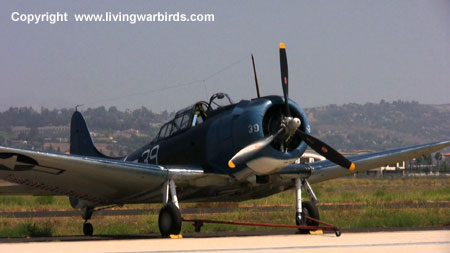 |
Maximum speed: 255 mph (410 km/h) Range: 773 mi (1,240 km) Service ceiling 25,530 ft (7,780 m) Rate of climb: 1,700 ft/min (8.6 m/s) Powerplant: Wright R-1820-60 radial engine, 1,200 hp (895 kW) |
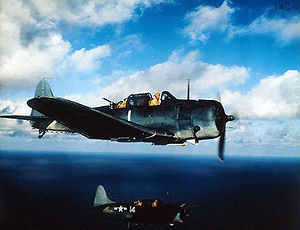 (Image: United States Navy SBD-5 Dauntless)
(Image: United States Navy SBD-5 Dauntless)
The Douglas SBD Dauntless was a naval dive bomber made by Douglas during World War II. The SBD was the United States Navy's main dive bomber from mid-1940 until late 1943, when it was supplanted, although not entirely replaced, by the SB2C Helldiver.
Role: Dive bomber
National origin: United States
Manufacturer: Douglas
First flight: 1 May 1940
Introduced: 1940
Retired: 1959 (Mexico)
Primary users: United States Navy, United States Marine Corps, United States Army Air Force, Free French Air Force
Number built: 5,936
Developed from: Northrop BT
Design and development
The Northrop BT-1 provided the basis for the SBD, which began manufacture in 1940. Ed Heinemann led a team of designers who considered a development with a 1,000 horsepower Wright Cyclone powerplant. A year earlier, both the U.S. Navy and Marine Corps had placed orders for the new dive bombers, designated the SBD-1 and SBD-2 (the latter had increased fuel capacity and different armament). The former went to the Marine Corps in late 1940, and the latter went to the Navy in early 1941.
The next version, designated SBD-3, began manufacture in early 1941. It provided increased protection, self-sealing fuel tanks, and four machine guns. The SBD-4 provided a 12-volt (from 6) electrical system, and a few were converted onto SBD-4P reconnaissance platforms.
The next (and most produced) variant, the SBD-5, was primarily produced at the Douglas plant at Tulsa, Oklahoma. It was equipped with a 1,200 hp (895 kW) engine and increased ammunition. Over 2,400 were built, and a few were shipped to the Royal Navy for evaluation. In addition to American service, the type saw combat against the Japanese with No. 25 Squadron of the Royal New Zealand Air Force which soon replaced them with F4U Corsairs, and against the Germans with the Free French Air Force. A few were also sent to Mexico. The final version, the SBD-6, provided more improvements but production ended in summer 1944.
The U.S. Army had its own version of the SBD, known as the A-24 Banshee, which lacked the tail hook used for carrier landings, and a pneumatic tire replaced the solid tail wheel. First assigned to the 27th Bombardment Group (Light) at Hunter Field, Ga., A-24s participated in the Louisiana maneuvers during September 1941. There were three versions of the Banshee (A-24, the A-24A and A-24B) used by the Army in the early stages of the war. The USAAF used 948 of the 5,937 Dauntlesses built.
Operational history
 (Image: A restored SBD Dauntless)
(Image: A restored SBD Dauntless)
The SBD was involved in combat from the first day of the Pacific War, as Dauntlesses arriving at Hawaii from USS Enterprise were caught in the Pearl Harbor attack.
The U.S. Army sent 52 A-24 Banshees in crates to the Philippine Islands in fall 1941 to equip the 27th Bombardment Group, whose personnel arrived separately. However with the attack of Pearl Harbor, these aircraft were diverted to Australia and the 27th BG fought on Bataan as infantry. While in Australia, these aircraft were reassembled for flight to the Philippines, but missing parts including solenoids, trigger motors, and gun mounts delayed shipment.
 (Image: The gunner of an SBD Dauntless aims his plane's twin .30 caliber machine guns aboard USS Independence.)
(Image: The gunner of an SBD Dauntless aims his plane's twin .30 caliber machine guns aboard USS Independence.)
Plagued with mechanical problems the A-24s were diverted to the 91st Bombardment Squadron and designated for assignment to Java instead. On 17 February 1942, only seven of the original 52 A-24s were combat ready. The A-24s had worn-out engines, no armor plating, and no self sealing fuel tanks. Referring to themselves as "Blue Rock Clay Pigeons", the 91st attacked the enemy harbor and airbase at Bali and damaged or sunk numerous ships around Java. After the Japanese shot down two A-24s and damaged three so badly they could no longer fly, the 91st received orders to evacuate Java in early March, ending a brief but valiant effort.
The Banshees left in Australia were assigned to the 8th Bombardment Squadron, 3rd Bombardment Group, to defend New Guinea. On 26 July 1942, seven A-24s attacked a convoy off Buna, but only one survived: the Japanese shot down five of them and damaged the sixth so badly that it did not make it back to base. Regarded by many pilots as too slow, too short-ranged and too poorly armed, the remaining A-24s were relegated to non-combat missions. In the United States, the A-24s became training aircraft or towed targets for aerial gunnery training. The more powerful A-24B was used later against the Japanese forces in the Gilbert Islands.
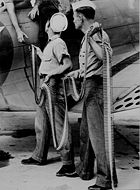 (Image: Belted cartridges loaded aboard SBD-3 at NAS Norfolk, 1942)
(Image: Belted cartridges loaded aboard SBD-3 at NAS Norfolk, 1942)
The type's first major use was in the Battle of the Coral Sea, when SBDs and TBDs sank the Japanese aircraft carrier Shoho. SBDs were also used as anti-torpedo combat air patrol and scored several times against Japanese aircraft trying to attack USS Lexington and USS Yorktown.
Their relatively heavy gun armament (two forward firing .50 caliber machine guns, one to two rear flexible-mount .30 caliber machine guns) was effective against the lightly built Japanese fighters, and many pilot-gunner combinations took an aggressive attitude to fighters which attacked them. One pilot, "Swede" Vejtasa, was attacked by three A6M Zero fighters and managed to hold them off and down all three in the process. (His skill as a fighter pilot thus clearly demonstrated, he was transferred to fly fighters; in October 1942, no longer an SBD pilot, he downed seven enemy planes in one day.)
 (Image: SBD-5)
(Image: SBD-5)
However, the SBD's most important contribution to the American war effort probably came during the Battle of Midway (early June 1942), when SBD dive bomber attacks sank all four of the Japanese aircraft carriers, three of them in the space of just six minutes (the Akagi, Kaga, Soryu and Hiryu) as well as heavily damaging two Japanese cruisers (including the Mikuma, which sank before a Japanese destroyer could scuttle it).
At Midway, Marine SBDs were not as effective. One squadron, VMSB-241, operating from Midway Island, was not trained in the "Helldiving" technique; instead, the new pilots resorted to the slower but easier glide bombing technique, which led to heavy losses. The carrier-borne squadrons, on the other hand, were much more effective, combined with their F4F Wildcat fighter escorts. It should also be mentioned the success of dive bombing was due to two important circumstances: First and foremost, the Japanese carriers were at their most vulnerable, readying bombers for battle, with full fuel hoses and armed ordnance strewn across their hangar decks. Second, the valiant but doomed assault of the TBD Devastator squadrons from the American carriers had drawn the Japanese fighter cover away from the dive bombers, thereby allowing the SBDs to attack unhindered.
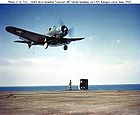 (Image: SBD Dauntless goes around for another landing attempt, after being "waved off" by the Landing Signal Officer on USS Ranger CV-4, circa June 1942)
(Image: SBD Dauntless goes around for another landing attempt, after being "waved off" by the Landing Signal Officer on USS Ranger CV-4, circa June 1942)
Next, SBDs participated in the Guadalcanal campaign, both from American carriers and Henderson Field on Guadalcanal Island. Dauntlesses contributed to the heavy loss of Japanese shipping during the campaign, including the carrier Ryujo near the Solomon Islands on 24 August, damaging three others during the six-month campaign. SBDs proceeded to sink one cruiser and nine transports during the decisive Naval Battle of Guadalcanal.
During the decisive time of the Pacific Campaign, the SBD's strengths and weaknesses became evident. Interestingly, while the American strength was dive bombing, the Japanese stressed their Nakajima B5N "Kate" torpedo bombers, which caused the bulk of the damage at Pearl Harbor.
 (Image: A SBD from the USS Yorktown CV-10, over Wake Island piloted by Lieut. Ridge Radney of bombing squadron VB-5, 5 October or 6 October, 1943. Photographed by LT Charles Kerlee of the Naval Aviation Photographic Unit commanded by LCDR Edward Steichen)
(Image: A SBD from the USS Yorktown CV-10, over Wake Island piloted by Lieut. Ridge Radney of bombing squadron VB-5, 5 October or 6 October, 1943. Photographed by LT Charles Kerlee of the Naval Aviation Photographic Unit commanded by LCDR Edward Steichen)
Although it was already reaching obsolescence by 1941, the SBD was used until 1944 when the Dauntless undertook its last major action during the Battle of the Philippine Sea.
However, some Marine squadrons utilized Dauntlesses until the end of the war. It had already been replaced by the SB2C Helldiver in the U.S. Navy, much to the dismay of the pilots, many of whom believed the "Slow But Deadly" Dauntless was a better aircraft than the Helldiver, which gained the nickname "Son of a Bitch 2nd Class." The Dauntless was one of the most important aircraft in the Pacific Theatre of World War II, sinking more enemy shipping in the Pacific war than any other Allied aircraft. In addition, Barrett Tillman, in his book on the Dauntless, claims that the Dauntless has a "plus" score against enemy aircraft, a rare event for a nominal "bomber" indeed.
A total of 5,936 SBDs were produced in World War II.
Variants
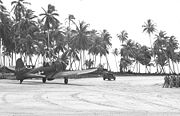 (Image: A-24B taxiing at Makin Island.)
(Image: A-24B taxiing at Makin Island.)
SBD-1 and SBD-2 (the latter had increased fuel capacity and different armament). The former went to the Marine Corps in late 1940, and the latter went to the Navy in early 1941.
SBD-3, began manufacture in early 1941. It provided increased protection, self-sealing fuel tanks, and four machine guns.
SBD-4 provided a 12-volt (from 6) electrical system, and a few were converted onto SBD-4P reconnaissance platforms.
SBD-5, the next (and most produced) variant, the was primarily produced at the Douglas plant at Tulsa, Oklahoma. It was equipped with a 1,200 hp (895 kW) engine and increased ammunition. Over 2,400 were built, and a few were shipped to the Royal Navy for evaluation. In addition to American service, the type saw combat against the Japanese with No. 25 Squadron of the Royal New Zealand Air Force which soon replaced them with F4U Corsairs, and against the Germans with the Free French Air Force. A few were also sent to Mexico.
SBD-6, The final version, theprovided more improvements but production ended in summer 1944.
A-24 Banshee - The USAAF equivalent of the SBD-3.
A-24A Banshee - The USAAF equivalent of the SBD-4.
A-24B Banshee - The USAAF equivalent of the SBD-5.
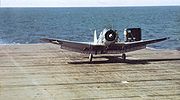 (Image: SBD Dauntless landing aboard USS Ranger CV-4)
(Image: SBD Dauntless landing aboard USS Ranger CV-4)
Specifications (Douglas SBD Dauntless)
General characteristics
Crew: Two
Length: 33 ft 1 in (10.08 m)
Wingspan: 41 ft 6 in (12.65 m)
Height: 13 ft 7 in (4.14 m)
Wing area: 325 ft² (30.19 m²)
Empty weight: 6,404 lb (2,905 kg)
Loaded weight: 10,676 lb (4,843 kg)
Max takeoff weight: 10,700 lb (4,853 kg)
Powerplant: 1× Wright R-1820-60 radial engine, 1,200 hp (895 kW)
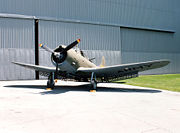 (Image: A-24 of the USAF museum)
(Image: A-24 of the USAF museum)
Performance
Maximum speed: 255 mph (410 km/h)
Range: 773 mi (1,240 km)
Service ceiling 25,530 ft (7,780 m)
Rate of climb: 1,700 ft/min (8.6 m/s)
Wing loading: 32.8 lb/ft² (160.4 kg/m²)
Power/mass: 0.11 hp/lb (0.18 kW/kg)
 Armament
Armament
Guns:
2x 0.50 cal (12.7 mm) forward-firing Browning M2 machine guns in engine cowling
1x 0.30 cal (7.62 mm) flexible-mounted Browning machine guns in rear (later versions fitted with 2x machine guns of the same caliber)
Bombs: 2,250 lb (1,020 kg) of bombs
The SBD Dauntless is also sometimes referred to as: sbd-5 dauntless, sbd dauntless 1, sbd dauntless dive bomber, sbd dauntless model, douglas sbd 3 dauntless, douglas dauntless, dauntless dive-bomber, dauntless for sale, sbd dive bomber, accurate miniatures dauntless.
Source: WikiPedia